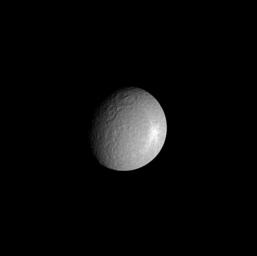
|
A Real Shiner
- Click the image above for a larger view
- Full-Res JPEG (909 x 907) (17.2 kB)
- Full-Res TIFF (909 x 907) (124.9 kB)
Caption:
Saturn's moon Rhea shows off the moon equivalent of a black eye -- a bright, rayed crater near its eastern limb.
Rhea is about half the size of Earth's moon. At 1,528 kilometers (949 miles) across, it is the second-largest moon orbiting Saturn.
The image was taken in visible light with the Cassini spacecraft narrow angle camera on Oct. 24, 2004, at a distance of about 1.7 million kilometers (1 million miles) from Rhea and at a Sun-Rhea-spacecraft, or phase, angle of 40 degrees. The image scale is approximately 10 kilometers (6 miles) per pixel. Cassini will image this hemisphere of Rhea again in mid-January 2005, just after the Huygens probe landing on Titan - with approximately 1-kilometer (0.6-mile) resolution.
Background Info:
The Cassini-Huygens mission is a cooperative project of NASA, the European Space Agency and the Italian Space Agency. The Jet Propulsion Laboratory, a division of the California Institute of Technology in Pasadena, manages the Cassini-Huygens mission for NASA's Office of Space Science, Washington, D.C. The Cassini orbiter and its two onboard cameras, were designed, developed and assembled at JPL. The imaging team is based at the Space Science Institute, Boulder, Colo.
For more information, about the Cassini-Huygens mission visit, http://saturn.jpl.nasa.gov and the Cassini imaging team home page, http://ciclops.org .
Cataloging Keywords:
| Name | Value | Additional Values |
|---|---|---|
| Target | Rhea | Saturn, Titan |
| System | Saturn | |
| Target Type | Satellite | Planet |
| Mission | Cassini-Huygens | |
| Instrument Host | Cassini Orbiter | Huygens Probe |
| Host Type | Orbiter | Lander, Probe |
| Instrument | Imaging Science Subsystem (ISS) | |
| Detector | Narrow Angle Camera | |
| Extra Keywords | Crater, Grayscale, Visual | |
| Acquisition Date | ||
| Release Date | 2004-11-22 | |
| Date in Caption | 2004-10-24 | |
| Image Credit | NASA/JPL/Space Science Institute | |
| Source | photojournal.jpl.nasa.gov/catalog/PIA06525 | |
| Identifier | PIA06525 | |
